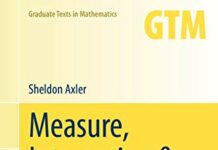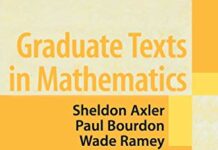
Ebook Info
- Published:
- Number of pages:
- Format: PDF
- File Size: 3.05 MB
- Authors: Sheldon Axler
Description
This best-selling textbook for a second course in linear algebra is aimed at undergrad math majors and graduate students. The novel approach taken here banishes determinants to the end of the book. The text focuses on the central goal of linear algebra: understanding the structure of linear operators on finite-dimensional vector spaces. The author has taken unusual care to motivate concepts and to simplify proofs. A variety of interesting exercises in each chapter helps students understand and manipulate the objects of linear algebra.The third edition contains major improvements and revisions throughout the book. More than 300 new exercises have been added since the previous edition. Many new examples have been added to illustrate the key ideas of linear algebra. New topics covered in the book include product spaces, quotient spaces, and dual spaces. Beautiful new formatting creates pages with an unusually pleasant appearance in both print and electronic versions.No prerequisites are assumed other than the usual demand for suitable mathematical maturity. Thus the text starts by discussing vector spaces, linear independence, span, basis, and dimension. The book then deals with linear maps, eigenvalues, and eigenvectors. Inner-product spaces are introduced, leading to the finite-dimensional spectral theorem and its consequences. Generalized eigenvectors are then used to provide insight into the structure of a linear operator.
User’s Reviews
Reviews from Amazon users which were colected at the time this book was published on the website:
⭐In my opinion: It’s good but, the concise format (small short book) has all explanations, examples and definitions limited to a formal compact form, and it is this brevity that gives the book its deficiencies in communicating Linear Algebra. I have learned the concepts much faster watching the swath of free tutorials online, like Dr. Aviv Censor or MIT open course-ware, and using Gilbert Strang’s Linear Algebra Book. Examples could use more expounding, with more statements linking concepts together for coherence and understanding, preferably with more basic common vocabulary (informal style) instead of the typical academic bombastic style (formal style).
⭐I used this book in my second course in linear algebra, and I absolutely loved it.One of my biggest points of irritation in my first course in linear algebra was the fact that we first defined determinant as some unintuitive, computational nonsense and then defined eigenvalues from there. Judging off of the foreword, Axler essentially wrote this book so that students like myself could gain some peace of mind.The material is developed wonderfully, in my opinion — it was much more intuitive than my first pass at linear algebra, and the problems within the book (at least those that my professor assigned) were commonly quite good. On top of that, it was one of the first math textbooks I’ve owned that I could legitimately sit down and read rather than, say, fall asleep or come away more confused than when I first started reading. The proofs are *mostly* quite readable, and Axler definitely has an enjoyable writing style. Whether it’s the little surprises like getting to page 22 and seeing it labeled “~7pi” (there are other easter eggs of that variety, by the way) or writing an anecdote from the supreme court where one of the justices is caught up on the word “orthogonal” inside the chapter on inner products and norms (p. 174), he certainly does his best to make reading the book enjoyable.Apart from the material itself, though, as others have mentioned, the book is also just plain looks nice. I purchased a hardcover edition (which I believe may be the only style printed for the 3rd edition), and whether it’s the outer cover or the typeset they use inside, everything just has a nice, colorful pop to it. Coming in at ~330 pages and ~6.5W x 9.5H x 0.8D inches, the book is also compact, an aspect that made carrying it to and from campus each day a trivial task.As a whole, I have essentially nothing but praise for this text. Some may have wanted a linear algebra text that’s more computationally intensive, but I’d rather gain the conceptual understanding that Axler has to offer than manually row reduce or invert some arbitrary matrix any day. I absolutely don’t want to sell my copy — this text is one that I’m going to be happy to leave on my bookshelf and use as a reference whenever I find myself needing to freshen up on my linear algebra later in life.
⭐I think that the book bindings were made with cheap materials, taking into account that this book costs 40+ dollars, and probably made in United States. I expected that the book will be sewn in blocks and then glued. This book is only glued and sheets can fell apart if you fully open the book. You can compare this book crafting with a more cheap Dover book but instead with a hard cover, such a pain. I recommend that the bookbinding should be specified in the item description. This kind of books (hardcovers) and specially those of mathematics must last for many decades!
⭐I got this book as a refresher for some things on linear algebra. This book offers a very interesing exposition of the topics as it avoids determinants until the last chapter. It is very clear and well written.
⭐Teaches Linear Algebra as an Algebra. It’s flavor is very Abstract Algebra light (and working oen will carry over to the other).It is not, by itself, always excellent at creating intuition. Doing the exercises is part of that. Geometrically… well, you’ll probably get plenty of that over the course of … just existing in any semi-technical realm.Compared to, say, Strang’s excellent online intro course (not a fan of his book, but the lectures are great; opposite of axler) Strang os great at getting hands dirty with simple systems and developing strong, key intuitions. Axler takes those simple comprehensions and intuitions and elevates them to something more sublime and, potentially, much more powerful.Despite his harping about finite dimensional vector spaces early on, a large part of the material discusses Infinite dimensional vector spaces amd here is where LA really helps bring new intuitions.If you took Strang’s course you learn to approximate data using projections. If you read the correspondong section of Axler you come away having learned to approximate arbitrary functions in the infinite space of functions with some subset of your choosing. The inner product, abstractly defined, allows for almost arcanely powerful tasks.But, again, it’s an algebraist’s take on LA. That’s not for everyone.
⭐Truth is we in India think we are taught linear algebra from our schools, but are never taught linear algebra. What we are taught is to manipulate a certain set of numbers put in a matrix form that gives us answers for unknown reasons.Linear Algebra is beautiful. Much of it comes from geometry. But who is to know that based on what we are taught? Enter Axler. He painstakingly builds up your base in various topics like set theory, fields, bases, dimensions, projections to enable you to get to a point where you re-understand a part of maths that is lost to you, because of the way it has been taught.LADR is not complete – it doesn’t cover everything. But what it does cover is built. Not just in the book, but in the reader. It won’t be an easy read. But when you are done with about 130 pages of this book, you will get a fresh perspective on all of LA. and LA is pervasive in all of maths. Further, LA is pervasive in much of CS, and in all of machine learning. Getting into those fields without a complete understanding of LA is like entering a flower garden without a sense of smell.Why Linear Algebra?Matrix Algebra tells you how to get the numbers that you want. Linear Algebra tells you why you get them.Bonus: I believe Linear Algebra Done Right is Springer’s best seller across all the mathematics textbooks that it sells (saw this in an old excel sheet shared by springer with a publisher).Recommendation:1. For self study: Do Gilbert Strang if you want to get through your exams. But Strang is not rigorous. If you really like mathematics, there is no better book to start your journey in Linear Algebra than Axler.2. For college courses: Should be primary text for undergraduate LA students.
⭐This is a good SECOND book on linear algebra. This book will be relevant for mathematicians rather than engineers because it offers a structured, in-depth look at linear spaces, mappings and all related topics. I really like the way the book is structured: it is always clear, and examples of unintuitive topics (like linear maps) are always done in such as way as to make them easily understandable. I enjoyed the book and so will you.
⭐thoroughly recommend for anyone studying linear algebra and geometry. Very clear and easy to read lay out with exercises and answers.
⭐Fantastic book exactly what I needed
⭐Good content, just takes a bit of thinking about get it. Although that’s my problem haha
Keywords
Free Download Linear Algebra Done Right (Undergraduate Texts in Mathematics) 3rd Edition in PDF format
Linear Algebra Done Right (Undergraduate Texts in Mathematics) 3rd Edition PDF Free Download
Download Linear Algebra Done Right (Undergraduate Texts in Mathematics) 3rd Edition PDF Free
Linear Algebra Done Right (Undergraduate Texts in Mathematics) 3rd Edition PDF Free Download
Download Linear Algebra Done Right (Undergraduate Texts in Mathematics) 3rd Edition PDF
Free Download Ebook Linear Algebra Done Right (Undergraduate Texts in Mathematics) 3rd Edition


